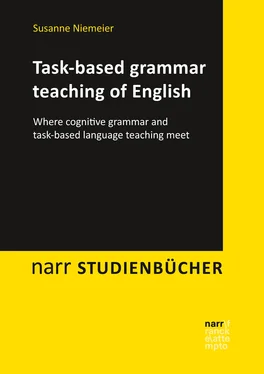Meaning extensions are generally motivated by either metaphor or metonymy. Such non-literal uses of language are largely neglected by traditional teaching approaches, whereas cognitive grammar sees them as important facets of human cognitive processing and as pervading all aspects of language. Metaphor and metonymy rely on either conventionalised or novel mental images that a speaker makes use of, not only lexically but also grammatically, and they can especially help to explain non-prototypical usages6.
ACHARD (2004: 168) adequately sums up the suitability of cognitive grammar for pedagogic purposes by stating that cognitive grammar can contribute to language teaching “by integrating cognitive descriptive insights into compatible well-established models of L2 pedagogy” – such as, for example, task-based teaching. Such a combination of cognitive grammar and the task-based approach, which is dealt with more exhaustively in the following sub-chapter and especially in the second part of this book, seems promising. If cognitive-linguistic insights can be made accessible for learners through well-selected tasks, the learners should be able to get a more comprehensive understanding of the target structure(s) and their expressivity can be enhanced. When a learner encounters a communicative situation in which a native speaker is likely to make a specific linguistic choice, the learner can then make a similar choice of construal and thus advance on their way towards a native-like command of the foreign language. It is up to the teachers to present tasks to their learners in which such choices of construal become possible and are as transparent as possible for them.
3.3.2 Research on applied cognitive grammar
Due to the relatively recent interest in applying cognitive grammar principles to foreign language instruction, there is not that much research on this topic. Although quite a number of researchers have developed instructional ideas, not many of these were tested empirically under controlled conditions. In the more qualitative research, the focus was on a diversity of linguistic phenomena, such as for instance prepositions, phrasal verbs, case marking, modal auxiliaries, the polysemy of verbs, idioms, articles, the passive voice, aspect, tense and conditionals. The following paragraphs elucidate the most important results.
Prepositions are the research area which has received the most attention of all the grammar structures enumerated in the previous paragraph. LINDSTROMBERG already started out in 1998 to show how conceptual metaphor could be used to elucidate preposition meanings, and in his revised book from 2010 he has strengthened the cognitive approach even more. However, his analyses are not supported by tests or empirical data. TYLER/EVANS (2003, 2004) developed the approach of ‘principled polysemy’, which focuses on radial networks of prepositions while aiming at connecting their more marginal meanings to the core meaning (or to what TYLER/EVANS call the ‘proto-scene’).
This approach was tested in two intermediate ESL classes by MATULA (2007), who only took into account the basic and the temporal meanings of the prepositions on , in and at and left out their abstract meanings1. Although the ‘cognitive group’, which had received cognitive-linguistic explanations on how to connect the basic sense of a preposition to its extended temporal sense, did not significantly outperform the traditional group, to which the prepositions had been presented as formulaic sequences, it nevertheless showed “more consistent increases in use of the prepositions” (MATULA 2007: 539) as well as a heightened level of metalinguistic knowledge.
TYLER/MUELLER/HO (2011) also focused on the teaching of prepositions (in this case: to , for and at ) to two groups of ESL learners. In their experiment, the post-tests actually showed a significant gain for the cognitive group. ALMUOSEB (2016) tested Arabic, Japanese and Spanish learners of English on their use of the basic and extended meanings of the prepositions at , on and in , her main concern being the interference of the learners’ L1, as Arabic, for example, uses only one single preposition ( fi ) for the three English prepositions. She found out that the learners’ L1 did not play a significant role, that – contrary to many other research findings – the use of images did not help these learners and that, for all learners, at was the most problematic preposition.
KURTYKA (2001) reports on the teaching of phrasal verbs along cognitive-linguistic lines to Polish learners of English and not only found that the learners in the cognitive test group improved more than the learners having been taught with a traditional approach, but also that the cognitive learners reacted quite positively to the learning materials. KÖVECSES/SZABÓ (1996) as well as BOERS (2000) could also establish that making learners aware of the conceptual metaphors behind the particles2 of phrasal verbs helped them to outperform those learners who had only been given L1 translations or synonyms instead of cognitive-linguistic explanations. Similar results were obtained by YASUDA (2010) with Japanese learners of English.
However, these last-named studies were all designed more like pilot studies, as none of them had a controlled and rigorous empirical design. KOHL-DIETRICH ET AL. (2016), on the other hand, conducted a controlled and empirical study on the teaching of phrasal verbs with a cognitive group and a control group of English learners from a German secondary school. Although the researchers did not find a better performance of the cognitive group on the post-tests, the learners in the cognitive group proved to be significantly better at understanding novel phrasal verbs that they had not encountered before than the learners in the control group.
LIAMKINA (2008) conducted an experiment with learners of German as a foreign language, focusing on the dative case. For one complete term, students from the cognitive group received cognitive-linguistically oriented feedback whenever a mistake came up in their (written) use of the dative case, whereas the learners in the traditional group were given the traditional standard rules for the use of the dative. At the end of the term, the students in the cognitive group showed a statistically significant improvement in their use of the German dative case, whereas the traditional group did not.
GRADEL (2016) also developed teaching materials on the basis of cognitive grammar insights for the dative case as well as for the accusative case for learners of German as a foreign language at the CEFR level A1 and tested these materials. She did not only rely on cognitive grammatical explanations but additionally used grammar animations. In this case as well, the cognitive treatment group gained statistically significantly better results than the group which was taught in a traditional way.
Another area of grammar which has received the attention of a number of researchers are modal auxiliaries. TYLER/MUELLER/HO (2010) conducted a quasi-experiment with college students with diverse L1s who were quite advanced learners of English. Again, these learners were divided up into two groups, one group receiving a cognitive-linguistic treatment of modal auxiliaries, the other group receiving instruction that focused on the more traditional speech act approach. The cognitive-linguistic treatment involved visualisations, as the learners were presented with little stick figures enacting the basic and extended meanings of the modal auxiliaries. For example, when an outward force was implied (as in may , granting somebody permission and where a barrier was lifted, or as in must , where a social force exerting pressure on the stick figure was shown), the stick figures were shown to lift a barrier for somebody else or they were pushed from behind by another figure, respectively. In the post-test, the cognitive group outperformed the traditional group significantly.
Читать дальше












